The best reef-safe sunscreens to protect your skin and the ocean this summer
We've tested the best reef-safe sunscreens for every budget to keep you and the environment safe
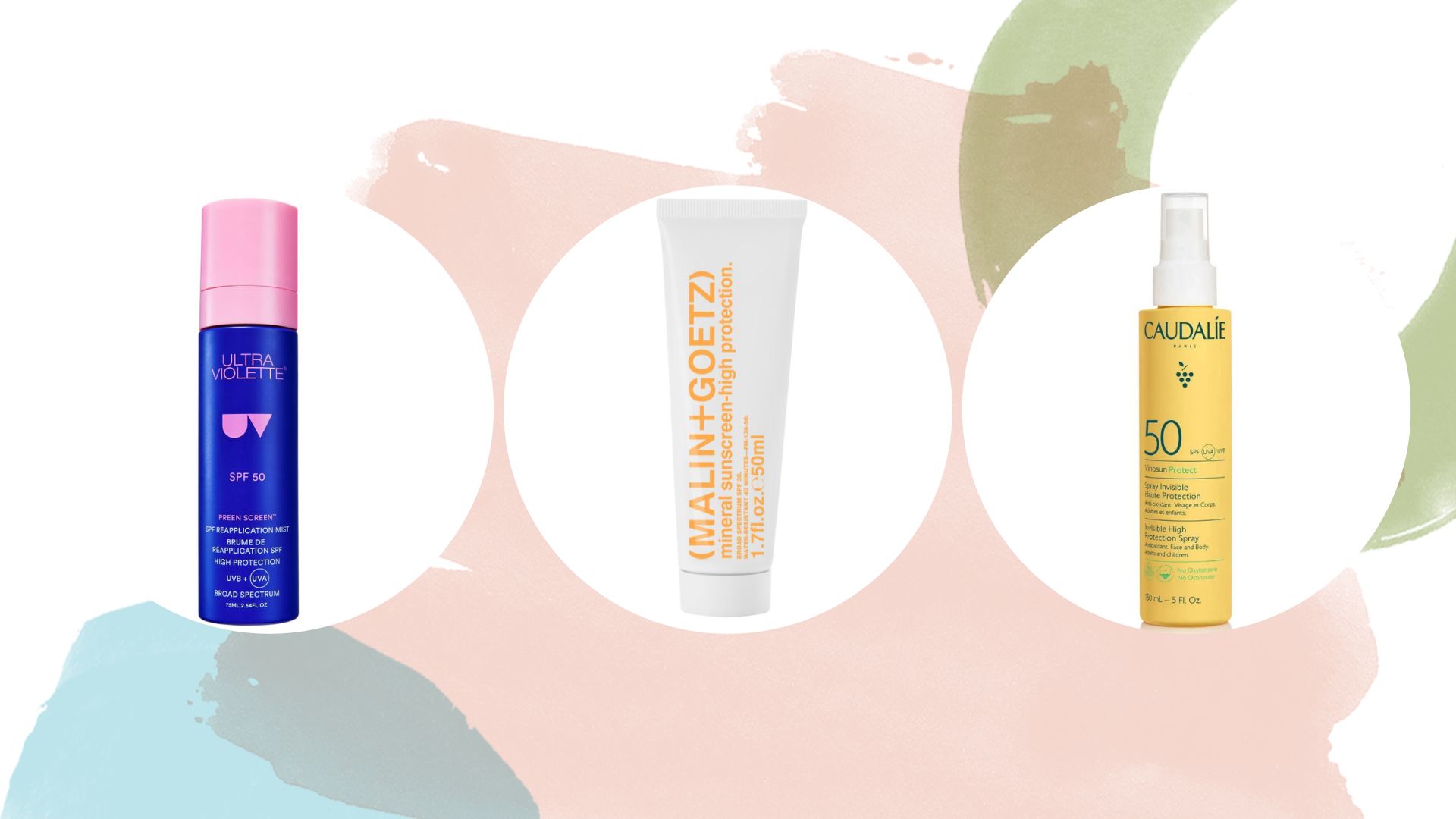

Jess Beech
Any form of sun protection, including reef-safe sunscreen, is good news. We’re well-informed on the importance of daily SPF defense in the fight against skin cancer and premature skin aging. But what you may be unaware of, or just starting to become conscious of, is the damage that certain sunscreens and their ingredients can inflict on the ocean.
Reef-safe is the new buzzword in sun lotion, a claim held by many of the best facial sunscreens as well as products intended to be used from top to toe. Scientists warned of the potential link between sunscreen and coral reef deterioration several years ago. Since then, Hawaii has banned the sale of sunscreen containing coral-harming chemicals (more on those later), and you’re likely to spot the phrases reef-safe and reef friendly on more and more bottles of SPF.
What’s tricky is that the phrase is still a bit of a gray area. “Reef-safe is not a protected or regulated term,” says cosmetic scientist Hannah Collingwood English. “But in general, it means the sunscreen does not contain UV filters octinoxate or oxybenzone. These two filters have been shown in lab conditions to cause coral bleaching, but the lab conditions did not reflect real-world conditions – the concentration of UV filters was much higher in the lab conditions.” Outside of the laboratory, however, there is real-life evidence of environmental problems caused by sunscreen. “On average about 25% of the sunscreen ingredients applied to the skin are released in the water over the course of a 20-minute submersion,” explains Charlotte Vøhtz, founder of Green People and organic beauty pioneer. “Chemicals that mimic the effect of oestrogen are common in sunscreens and can have a dramatic effect on aquatic life. Certain sunscreens also promote viral infections in coral reefs, potentially playing an important role in coral bleaching in areas with low water renewal where many tourists visit.”
So how can we tell if we’re using a reef-safe sunscreen? “Check that it does not contain oxybenzone, octinoxate, enzacamen, or zinc oxide. This is important because many sunscreens labeled “reef-friendly” or “reef safe” are operating under the assumption that it's chemical filters we need to worry about. In fact, zinc oxide (a mineral filter) is also an issue at similar concentrations.” As we said, it’s not black and white, and we’d advise doing your own research to decide where you stand on particular filters.
Whether you are generally interested in an eco-friendly lifestyle, want a nod to sustainable beauty in your routine, or simply have SPF questions about how sun care can affect coral, this guide has got you. We've tried and tested the best reef-safe sunscreen on the market and answered all your questions to help you protect yourself and the planet.
The best reef-safe sunscreen, chosen by our beauty editor

1. Malin + Goetz SPF30 Sunscreen High Protection
Our expert review:
Specifications
Reasons to buy
Reasons to avoid
Typically, anyone who’s looking for the best-reef sunscreen will gravitate towards mineral sunscreens. This one uses titanium dioxide, which has been shown to have no negative impact on marine life, alongside zinc oxide, which has been flagged as a potential concern but only at high percentages. Eco credentials aside, the great thing about mineral sunscreen when doing things like snorkeling near reefs is that it works immediately and tends to have better staying power than chemical sunscreen, which reduces the chance of you getting burnt (as well as the likelihood of the formula ending up in the ocean). If you thought mineral sunscreen was heavy and chalky then this is the SPF to change your mind, with a silky, barely-there consistency that absorbs beautifully. It spreads well too, so you can get a comforting amount of coverage.
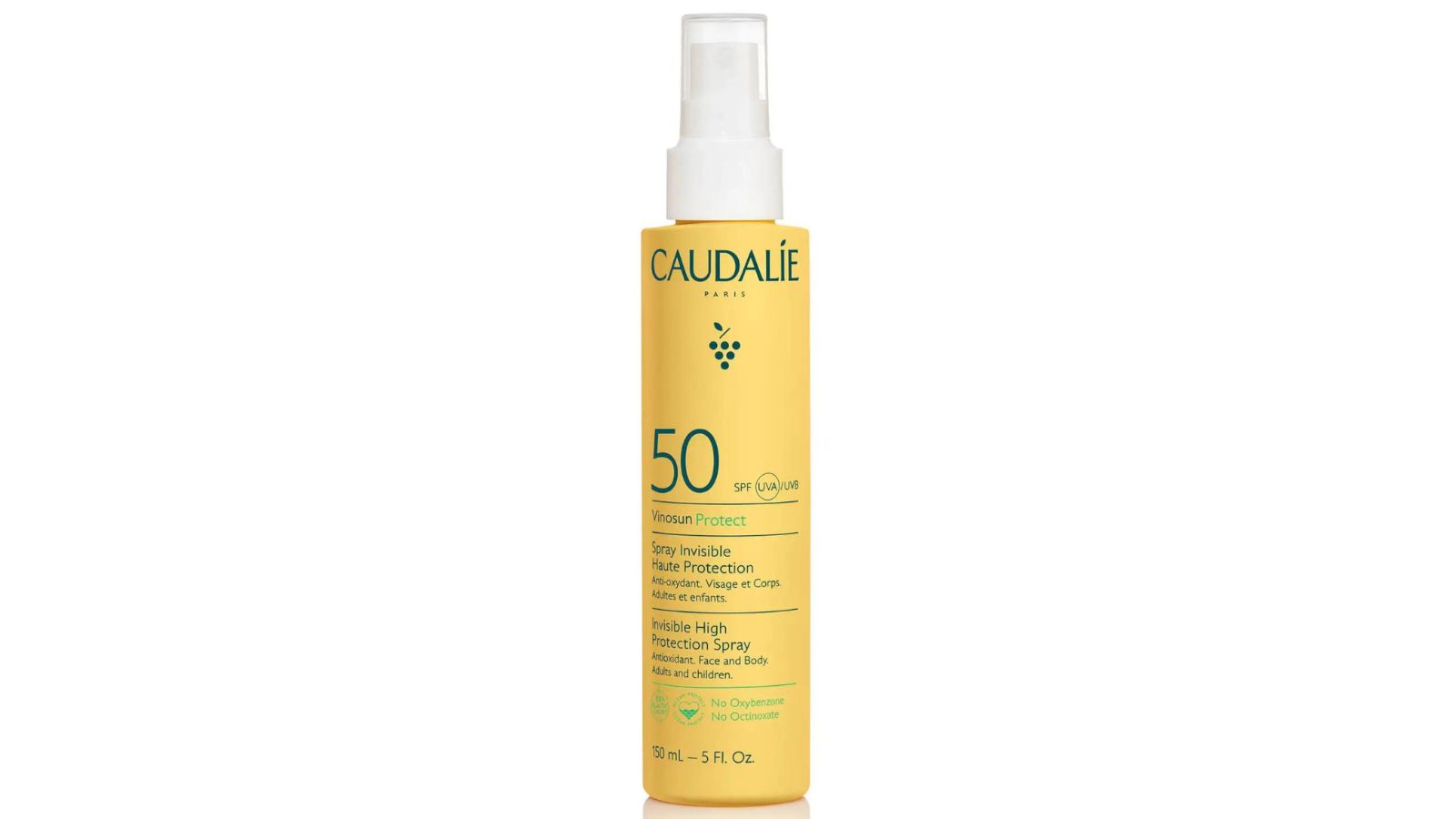
2. Caudalie Vinosun Protect Invisible High Protection Spray SPF50
Our expert review:
Specifications
Reasons to buy
Reasons to avoid
We never thought we’d be the sort of people to get over-excited about a sunscreen but this one deserves a little fanfare. Important things first, it’s a chemical sunscreen and free from octinoxate, octocrylene, and oxybenzone. What’s most special about it is how it feels to apply. It’s a silky fluid spray that glides onto the skin like a lightweight moisturizer and smells delicious. We have been asked on more than one occasion what perfume we’re wearing when all we had on was this sunscreen. It’s powered by the brand’s beloved French grape seed extract as well as vitamin E, to leave skin soft and glowing. Taking their commitment to the environment even further, since 2020 Caudalie has been collecting and recycling as much plastic from the ocean as they generate, keeping the amount of plastic they use stable despite how the company has grown.
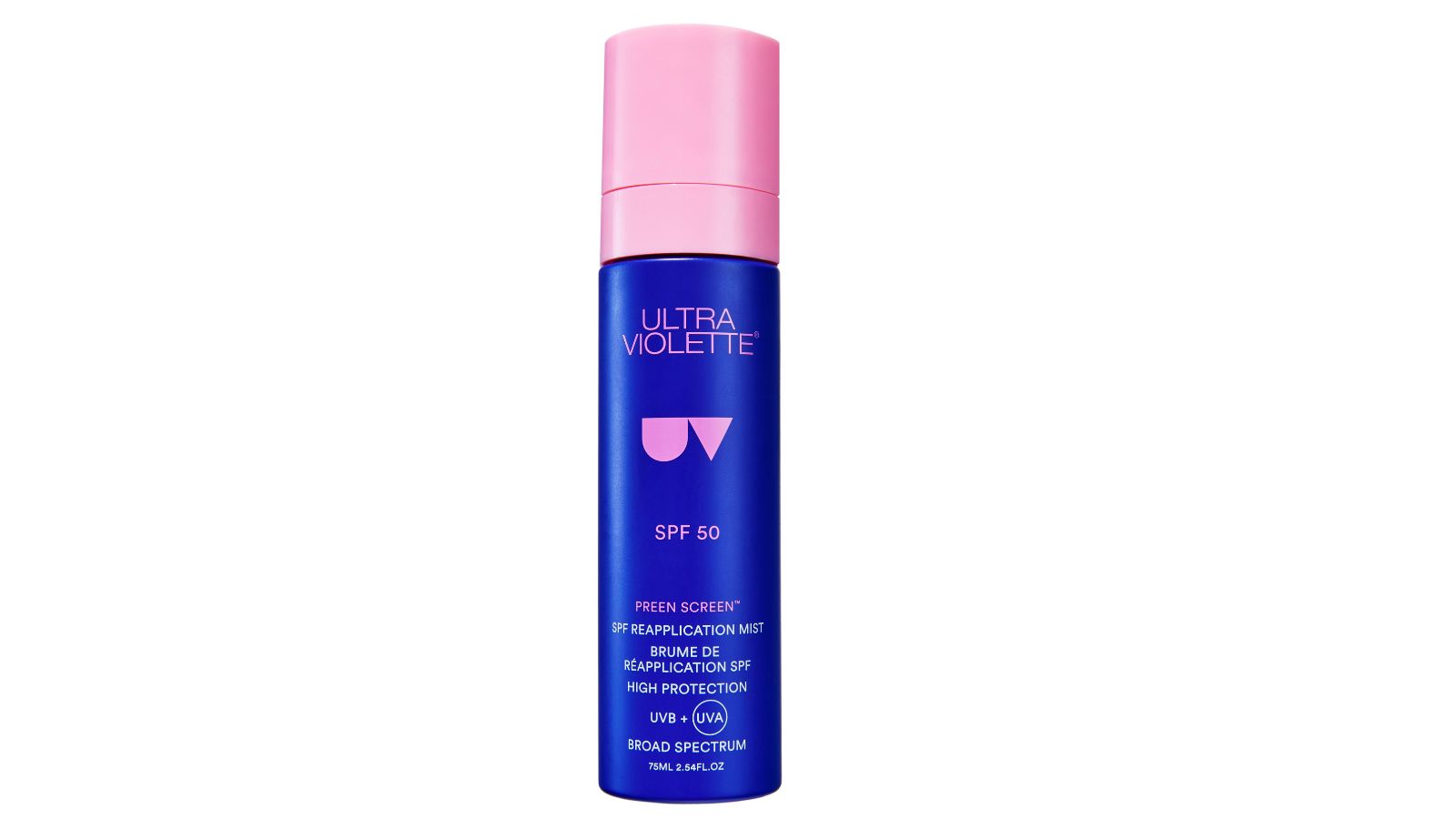
3. Ultra Violette Preen Screen SPF50
Our expert review:
Specifications
Reasons to buy
Reasons to avoid
Technically, if you’re taking your sun protection seriously, you should be reapplying thoroughly every two hours. But, that’s not entirely practical when you’re wearing a full face of makeup. This lightweight mist uses chemical filters (none of the ones on the banned list) to shield your skin without distorting your base. It’s completely clear, so there’s no peppering your skin in tell-tale white specs and it’s invisible on all skin tones. It’s not greasy but does leave a slight residue and glow on the skin – which is quite nice during the summer months. If that wasn’t enough, there’s also a cocktail of skincare-worthy ingredients in the tube, including balancing niacinamide, brightening vitamin C, and soothing vitamin E. Just make sure you close your eyes as you mist to prevent any stinging.

4. Ultrasun Family High Protection SPF30
Our expert review:
Specifications
Reasons to buy
Reasons to avoid
The brand’s patented lamellar technology delivers a formula that is long-lasting and non-greasy. It works by applying filters in fine, alternating layers that bond with the skin evenly, and protect by sitting just below the skin’s surface. This is a hybrid sunscreen, combining physical protection with chemical absorbers. Plus all this science is backed by environmentally-conscious ingredients. Ultrasun is the first sun care brand worldwide to be awarded the BASF ECOSUN pass status, a stringent testing process that examines SPF formulas to see if they are marine and ocean safe. Ultrasun not only met these requirements but surpassed them.
In terms of formula, the light lotion melts into the skin with very little effort leaving no hint of a white cast. Fun fact: it is the only sunscreen that our Beauty Editor's husband will happily wear, which speaks volumes about its near-invisible, un-sticky, quick-to-absorb formula. For us, it's always been a godsend on hot beach breaks and helped me to avoid prickly heat which we are usually afflicted with. No surprise then that the hypo-allergenic, oil-free, perfume-free formula is recommended by Dermatologists for those prone to skin allergies. A true sunscreen superstar.
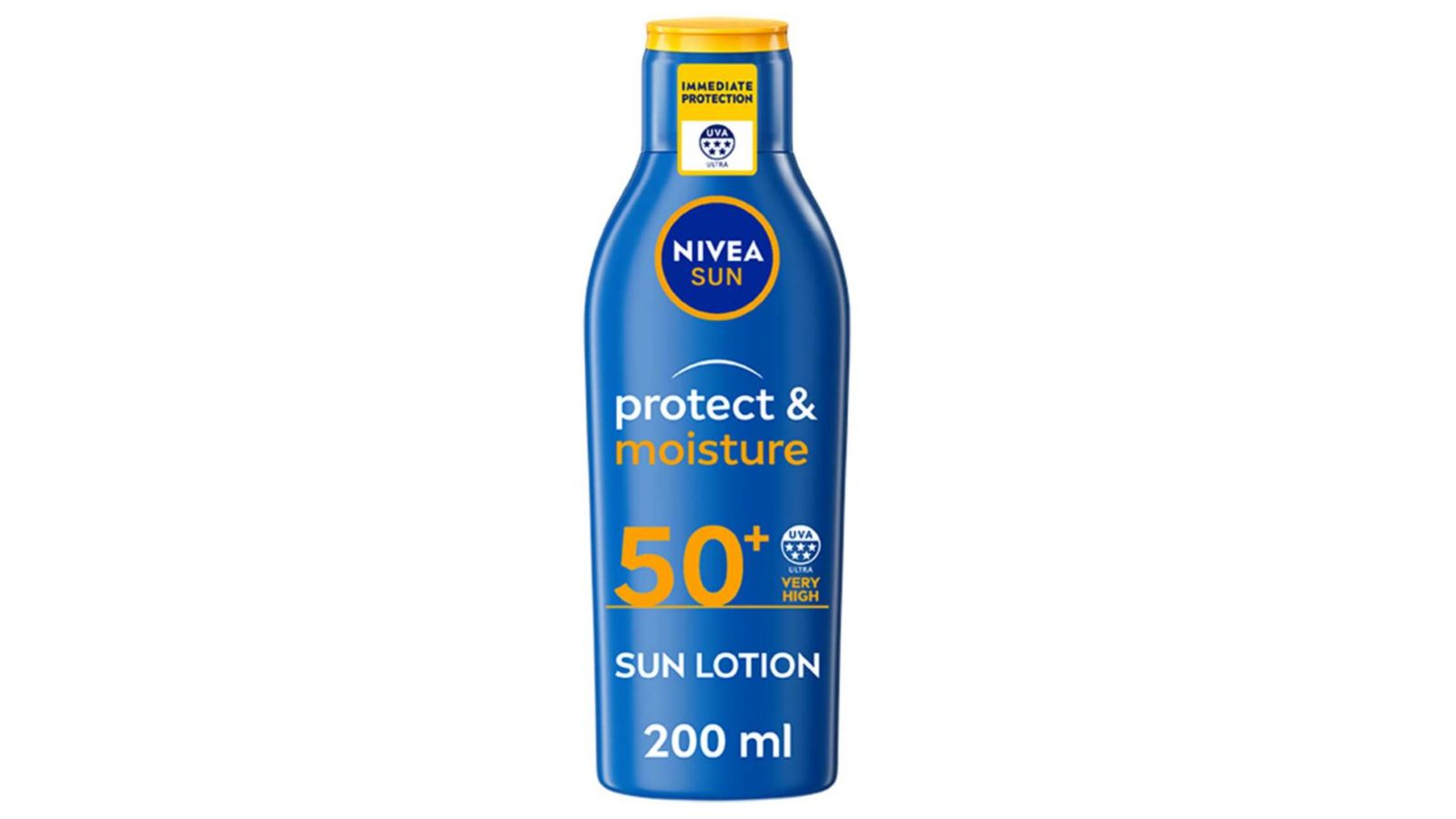
5. Nivea Sun Protect & Moisture SPF 50
Our expert review:
Specifications
Reasons to buy
Reasons to avoid
Nivea sunscreen will always hold happy memories of long, hot summers waiting for exam results. 20 years later, though the formula has come a long way, we find its distinct sunkissed scent just as appealing as we did as teens.
It’s got some brilliant credentials for the price - 5-star UVA protection, water resistance, and a 75% biodegradable reef-safe formula. There are skin perks too. The formula delivers instant and long-lasting hydration and works with the skin’s microbiome (the bacteria that make up a crucial component of our skin barrier) to keep everything balanced and prevent moisture loss. This is a fantastic option for families – trust us, sunscreen-phobic kids won't have much to moan about with this quick-absorbing formula. It's already a bargain, but you can often catch some of the best sunscreen deals on this reliable staple too.
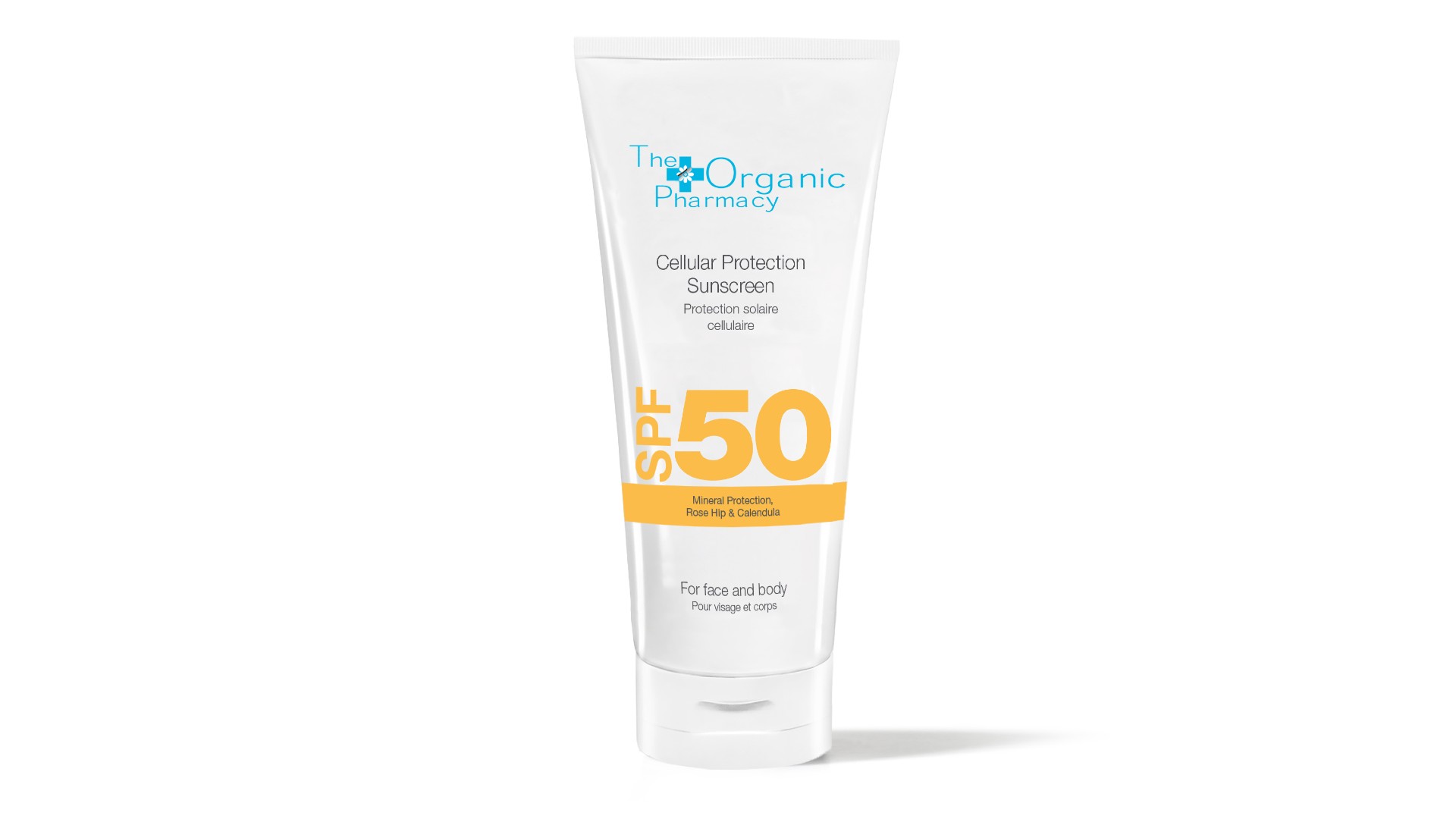
6. The Organic Pharmacy Cellular Protection SPF 50
Our expert review:
Specifications
Reasons to buy
Reasons to avoid
When a sunscreen formula is billed as being suitable for babies, you know it’s going to be a caring and cosseting treat for adult skin alike. It’s made from 59% organic ingredients, including shea butter and rosehip to bolster moisture levels. The defense comes from coral-safe zinc oxide and titanium.
The rich consistency is more like one of the best face moisturizers than a typical light sun lotion, so does require a little more rubbing in. But we're pleased to report it left no white cast on our Beauty Editor's olive complexion, and our skin felt plumped with hydration for the rest of the day. In fact, it’s been clinically proven to increase skin moisture by 18% when applied once a day for 28 days, which means it's also a great option for anyone wondering how to make a tan last longer (the trick is hydration). We also liked the fact this could be used on the face and body, and the skin-nourishing ingredients certainly left our dehydrated skin looking and feeling a lot better with each application.
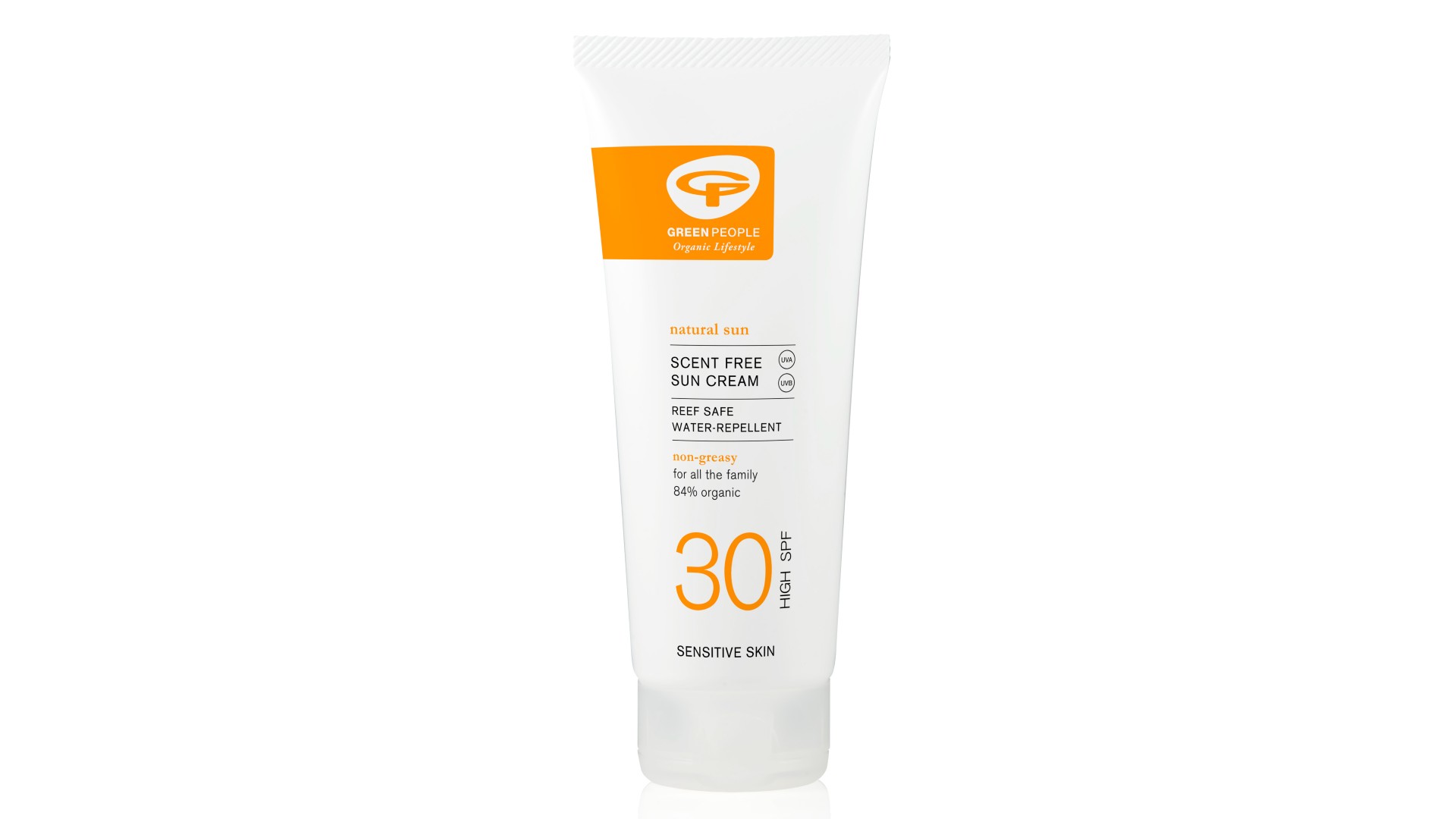
7. Green People Scent Free Sun Cream SPF 30
Our expert review:
Specifications
Reasons to buy
Reasons to avoid
Green People is the OG ocean-friendly sunscreen, having advocated for physical blocks over chemical versions for years, and only using ingredients that do not pose a threat to marine life. Even more admirably, Green People donate 20p from every purchase of their reef-friendly sunscreen to The Marine Conservation Society. And it’s not just good news for the planet. You can expect high-factor, broad-spectrum protection, meaning it protects against both UVA (the rays responsible for aging) and UVB (the ones that burn skin) rays using non-toxic filters. All of which makes it one of the best sunscreens for sensitive skin.
This is a great choice if you suffer from prickly heat - those sore, itchy, unsightly bumps occur when sweat ducts are blocked, trapping sweat under the skin until it becomes inflamed and peppered with a prickly rash. Green People’s formula is made without silicones or artificial fragrances, and anything else that’s likely to block pores and trigger a reaction in sensitive skin or eczema-prone skin. When skin can breathe, it’s less likely to break out. The cream itself absorbs exceptionally quickly, with no signs of tackiness or a white cast, leaving only soft, moisturized skin in its wake.
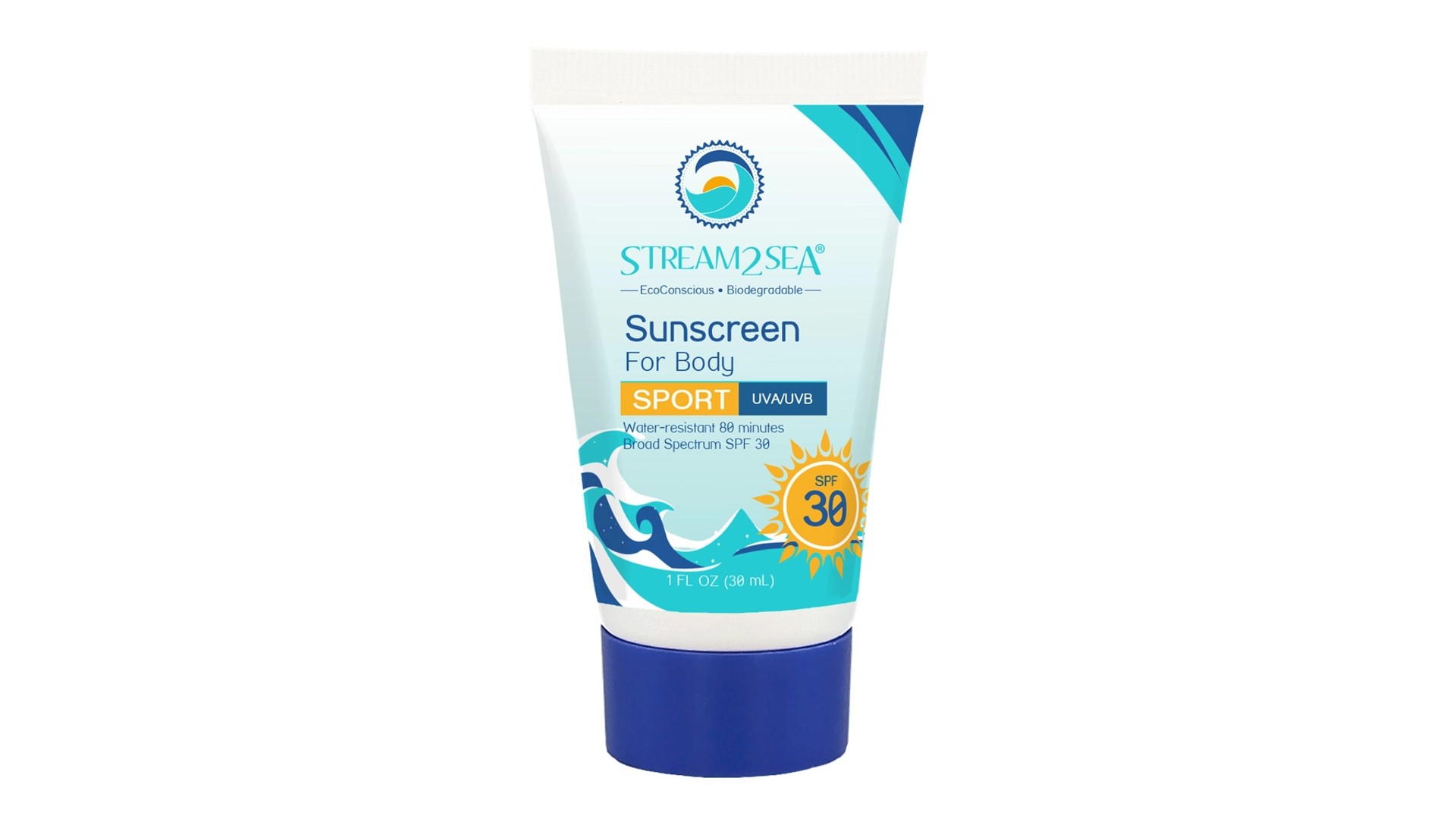
8. Stream2Sea Sport Sunscreen SPF 30
Our expert review:
Specifications
Reasons to buy
Reasons to avoid
If you’re super active, this is the sunscreen for you, providing 80 minutes of water-resistant, broad-spectrum protection when swimming, exercising, or sweating. Environmentally virtuous, it’s been proven safe for freshwater fish, saltwater fish and coral larvae, using non-nano titanium dioxide and biodegradable ingredients.
The formula doesn’t make your eyes sting and weep like other sunscreens, which is especially handy if you’re in and out of the water. It’s quite a thick lotion so a little definitely goes a long way. If you’re a bit overzealous, it can leave skin with a slight white sheen. But the cream is loaded with antioxidants and nourishing ingredients like coconut oil that felt pampering.
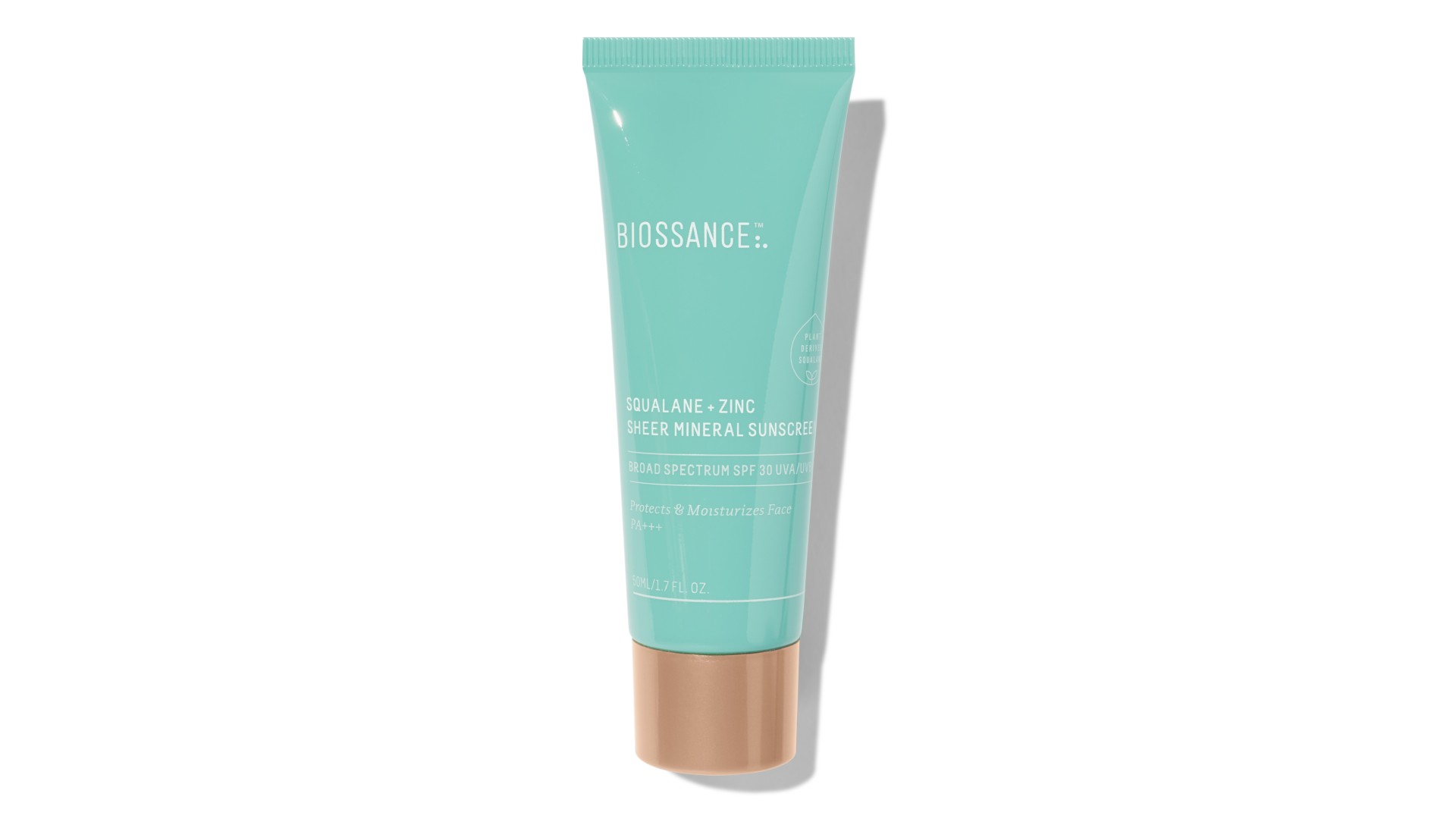
9. Biossance Squalane + Zinc Sheer Mineral Sunscreen SPF 30
Our expert review:
Specifications
Reasons to buy
Reasons to avoid
If you want to up the ante from your usual face moisturizer with SPF to a dedicated facial sunscreen, this reef-safe option could be a perfect choice. Deeper skin tones will be glad to hear that it goes on sheer, so there’s no mime-like white cast associated with other mineral sunscreens.
It’s also a lovely option for hot, sticky days when you really don’t want to wear make-up but kind of want that dewy makeup look. The soft-focus glow made our skin look healthy and, dare we say, rather fresh. It’s got hot-right-now squalane to lock in a big slurp of hydration without feeling greasy, making this one of the best sunscreens for acne-prone skin on our list. That squalane also helps the sunscreen glide over the skin. Our best foundation went on very smoothly over the top without any of that dreaded pilling.
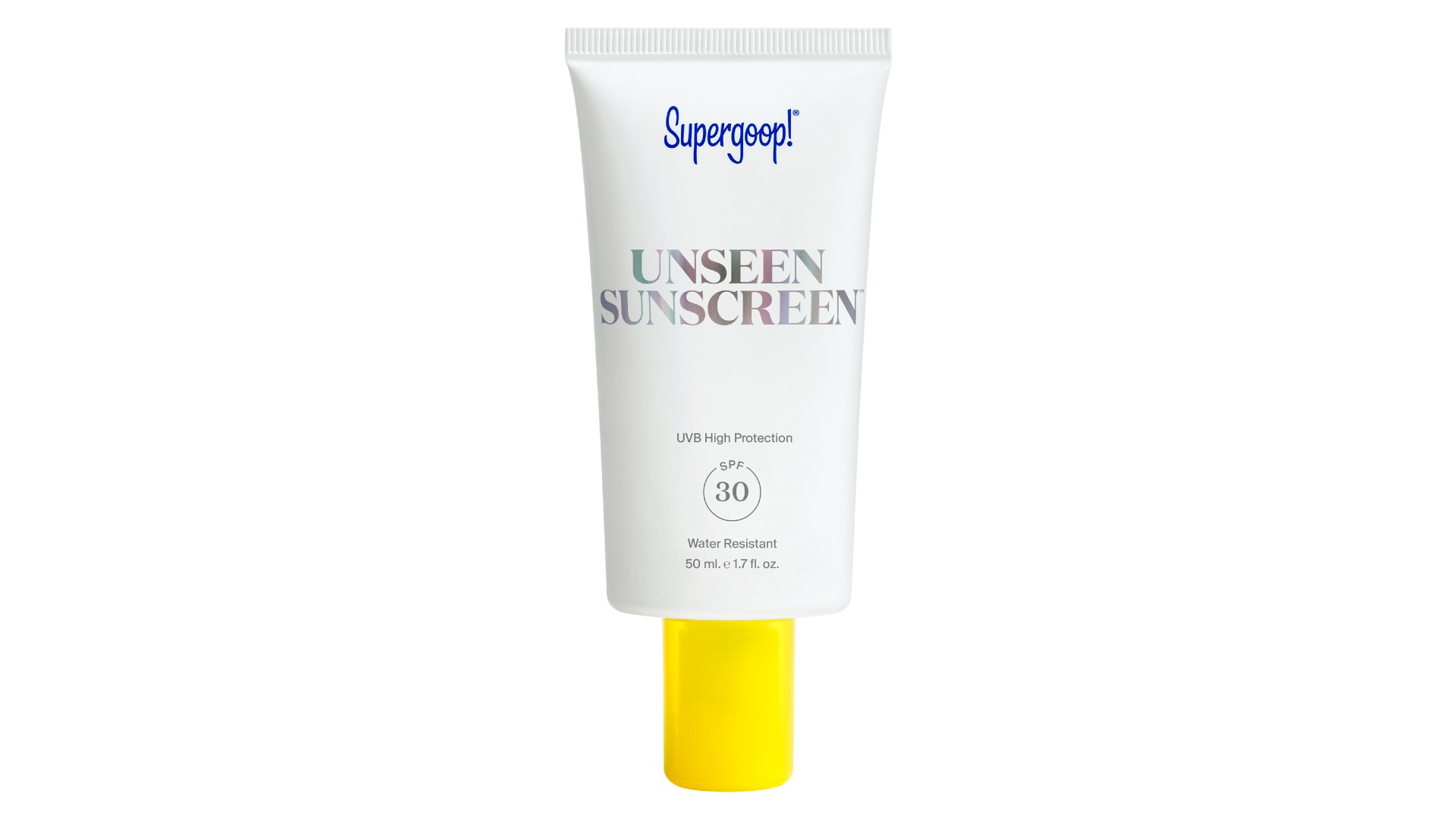
10. Supergoop! Unseen Sunscreen SPF 30
Our expert review:
Specifications
Reasons to buy
Reasons to avoid
Supergoop! was the first SPF brand not to use oxybenzone, and since then their ‘no list’ includes more than 1600 ingredients, including octinoxate. The ingredients they have included in this cult facial sunscreen work hard for your skin, like extract from meadowfoam seed to hydrate, frankincense to soothe and red algae to protect against the detrimental effects of blue light emitted from electronic devices.
It comes out clear with a putty-like consistency that smooths across the face effortlessly and becomes entirely undetectable. The velvety-matte finish is great for combination and oily skin types, and much like the best primers, gives great grip for any subsequent make-up you apply. Although it is on the pricey side for facial sunscreen, a little does go a long way.

11. Tropic Great Barrier Sun Lotion SPF 15
Our expert review:
Specifications
Reasons to buy
Reasons to avoid
This hybrid sun protector combines both mineral and chemical filters that have been deemed environmentally-, ocean- and skin-safe to provide solid protection against UVA and UVB rays, pollution, and blue light damage. It comes in SPF 15, 30, and 50 so there are plenty of choices to suit your needs.
We found the formula refreshingly silky and light – it sank in with little effort or patience required on my part. For a lotion so full of nourishing ingredients (Hyaluronic acid and vitamin E make skin feel soft and smooth), it didn’t leave any visible white sheen or sticky feeling.
How we tested the best reef-safe sunscreen
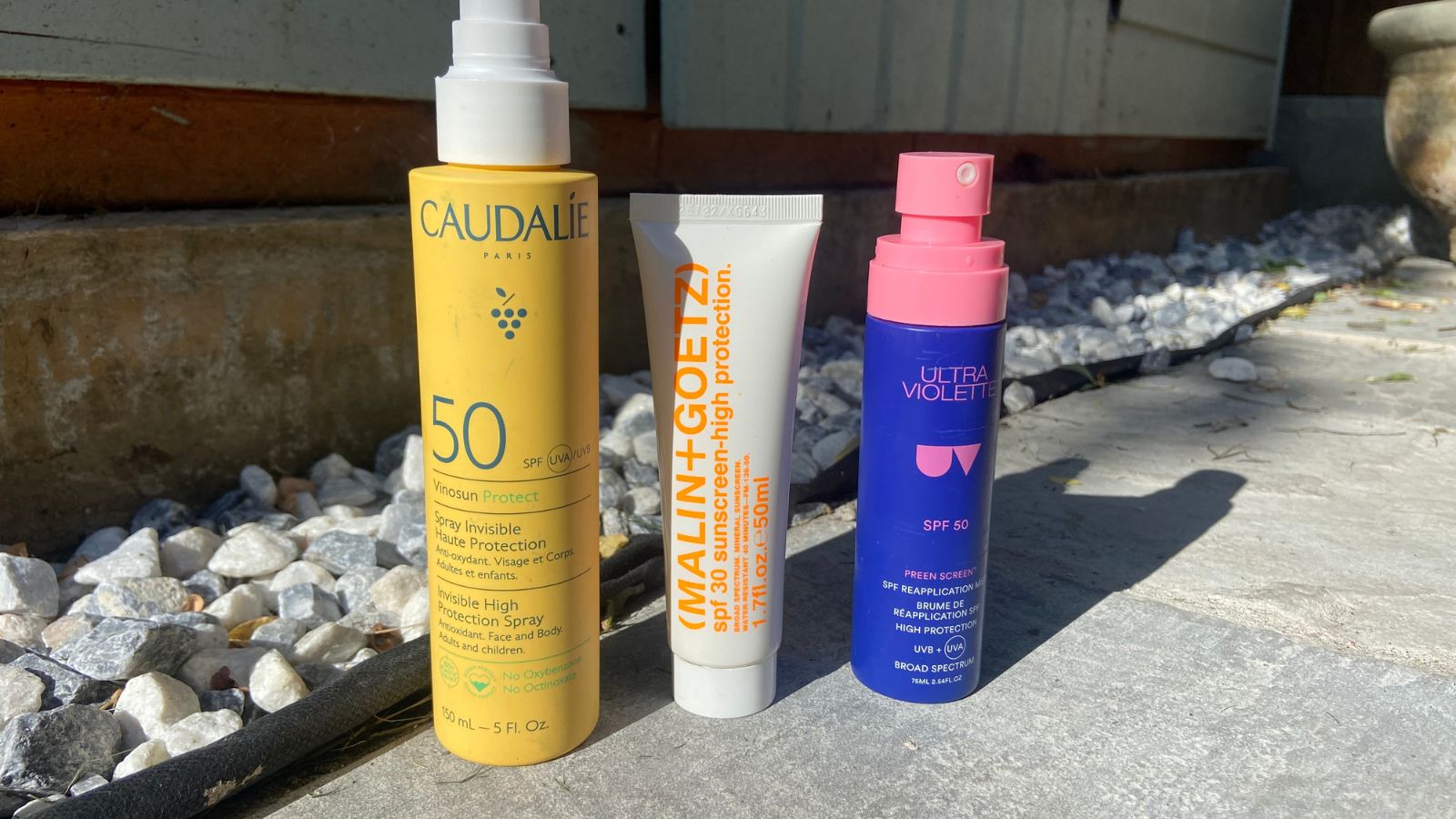
In order to make this list, the best reef-safe sunscreens needed first to have been considered safe for marine life including coral and fish. As we have already mentioned, reef-safe is not a protected term, and there are varying interpretations as to which ingredients are reef-safe. Once we were satisfied with each product's credentials, we applied them to our skin before sun exposure, making sure they worked for a range of skin tones and types. We paid close attention to how they felt on our skin, if we could apply our makeup on top with ease and of course how well they protected us against the sun (no SPF 10s on this list!)
How to choose the best reef-safe sunscreen
You’ll need to consider the following when selecting the best reef-safe sunscreen for you:
- Check the ingredients list. “Oxybenzone and octinoxate are common chemicals found in many sunscreens, particularly in spray-on types,” says Vøhtz. “Researchers have found that these chemicals harm marine life and have been found in high concentrations at some of the world's most popular coral reefs.” Other filters including enzacamene and zinc oxide are also thought to be problematic.
- Weigh up mineral vs chemical filters. Are all chemical filters bad for marine life? “No, and in most use cases there wouldn’t be a high enough concentration to have any effect,” explains Collingwood English. “We do know that oxybenzone, octinoxate, and enzacamene can cause problems at high enough concentrations, though. We also know that octocrylene, octisalate, avobenzone, octyl triazone, ecamsule and drometrizole trisiloxane have little to no effect. As for mineral UV filters, we know zinc oxide is not great at high concentrations but titanium dioxide has little to no effect.”
- Look for water-resistant. The more water-resistant your reef-safe sunscreen, the less likely it is to transfer into the ocean.
- Find a texture that works for you. Whether it’s one of the best reef-safe sunscreens or not, the best SPF formula is always the one you want to wear. Play around with textures to see which you’d be happy to apply liberally and reapply during the day.
- Consider the factor. Factor is an important well, factor, when choosing any sunscreen. Ideally, it should be as high as possible, which means SPF50. If you’re opting for SPF30 instead, make sure you’re applying enough to shield your skin properly.
- Think about where you’re wearing it. “It’s only really important if you will be swimming very close to coral because some of your sunscreen will wash off into the ocean and could accumulate to harm the coral,” says Collingwood English. “In other conditions, it’s highly unlikely for your sunscreen to reach coral in a high enough concentration to create issues.” In short, reef-safe sunscreen is only really a consideration if you’re swimming in the sea. If you’re spending time by the pool, it matters far less.
Why choose reef-safe sunscreen?
According to the environmentalist organization Green Cross, we dump about 25,000 tonnes of sun cream into the oceans every year, which works out at about 1 liter per second. There are chemicals in SPF - chiefly oxybenzone and octinoxate - that have been said to cause damage to coral reefs. These UV filters protect the skin by absorbing the sun’s rays before converting them to heat. Studies have shown that when coral has been exposed to Oxybenzone, it can lead to coral bleaching and have a detrimental impact on algae. This in turn affects the fish, marine life, and organisms that rely on these reefs.
What makes a sunscreen reef-friendly?
"Reef-safe or reef-friendly SPF formulas are usually deemed so by the absence of four ingredients identified as potentially having a negative environmental impact," explains Abi Cleeve, suncare expert and founder of Ultrasun. ‘These are Oxybenzone (Benzophenone-3,BP-3), Butylparaben, 4-methylbenzylidene camphor (4MBC), and Octinoxate (Ethylhexyl methoxycinnamate)." Always check the label to make sure your sunscreen is formulated without these offenders.
What ingredients should you avoid for reef-safe sunscreen?
The difficulty with the term 'reef-safe' is it is less of a regulation imposed by an official body and more of a guideline that brands use to reassure the consumer. The best thing to do is to check the label and make sure that the sunscreen does not contain any of the following ingredients on the HEL list.
- Any form of microplastic sphere or beads
- Any nanoparticles like zinc oxide or titanium dioxide
- Oxybenzone
- Octinoxate
- 4-methylbenzylidene camphor
- Octocrylene
- Para-aminobenzoic acid (PABA)
- Methyl Paraben
- Ethyl Paraben
- Propyl Paraben
- Butyl Paraben
- Benzyl Paraben
- Triclosan
It’s also worth pointing out though that sunscreen isn’t the only threat to coral reefs. Sewage, pollution, and rising sea temperatures caused by carbon emissions are perhaps the most significant causes of coral damage, so to say sunscreen is the biggest threat to marine life would be an overstatement. As Jo Ruxton from the charity Ocean Generation, says, "Our ocean has been bombarded with toxic chemicals following decades of industrial and agricultural waste pouring into it. Now we know the damage these can do, every step we can take to prevent it from worsening is critical.”
It’s clear that further research into the impact of sunscreen on the ocean environment is needed. However, we all want to make the best choices we can to protect our skin and the environment, and choosing a reef-safe sunscreen will limit the stress on coral. Every little helps, as they say. If you want to err on the side of caution, avoid sunscreens formulated with those ingredients that have been found to have a negative impact on coral.
Are mineral formulas better for reef-safe sunscreen than chemical?
Mineral sunscreens are often viewed as a kinder, more environmentally-friendly option. They are also generally considered to be better for sensitive skin. In fact, Holland & Barrett has gone so far as to ban the sale of all non-ocean-friendly sunscreen lines, carrying only 100% mineral formulas instead. Mineral sunscreens may currently be the more trusted option when it comes to the environment but as Cleeve says, "It’s important that we don’t oversimplify this. It isn’t a binary choice of chemical = bad and mineral = good." More research needs to be done and is ongoing to create sunscreens that benefit both our skin and the planet. Whether you opt for a mineral, chemical, or hybrid sunscreen, the best formula is the one that you are most comfortable with and most likely to slather on daily.
Sign up to our free daily email for the latest royal and entertainment news, interesting opinion, expert advice on styling and beauty trends, and no-nonsense guides to the health and wellness questions you want answered.

Stephanie Maylor is a Beauty Editor working across five national magazine titles, with almost 20 years' experience in the industry. She has written for many brands, including woman&home, Grazia, Now, More!, Fabulous, NW, Woman, Woman's Own, Woman's Weekly, Essentials, Best, Chat, and OK! online.
In 2010 she launched her own beauty blog, which was shortlisted for Best Beauty Blog in the 2011 and 2012 Johnson & Johnson Beauty Journalism Awards. She has interviewed many high profile industry experts and celebrities including Alesha Dixon, Twiggy and Christina Hendricks.